Asset Identification Rules
As mentioned in the feature activation step in the Third-Party Asset Import Workflow, contact the Technical Account Manager (TAM) to activate the third-party asset feature. Once done, you can create the asset identification rules to identify the third-party party assets scanned or discovered by various connectors, such as Webhook, Active Directory, and ServiceNow.
Important to know!
When assets are imported into CSAM through connectors, a time-based filter is applied to avoid duplicate processing of the same asset.
By default, if an asset with the same identifiers is received again within 12 hours, the system ignores the update and does not refresh the asset record. During this period, fields such as the last updated date do not change for that asset, even if data is re-imported successfully.
After the 12-hour window, the system processes the next import and synchronizes the asset information.
View Asset Identification Rule Details
Before creating the asset identification rule, see the details that you can view from the Configuration > Asset Identification Rules tab.

(a) Create New Rule: Create a new asset identification rule.
(b) Reset: Retain only the default system-generated asset identification rules.
(c) Default system-generated rules: See the default system-generated rules that are created using specific identification attributes.
(d) Reorder: See Reorder the asset identification rules.
Create an Asset Identification Rule
To create the asset identification rule, follow these steps:
- Navigate to Configuration > Asset Identification Rules tab, and click Create New Rule.
- Enter the rule name.
- Select the checkboxes next to the required fields from the Available Fields section and click the single arrow key
 icon.
icon.
The fields are moved to the Selected Fields section. These fields are the attributes based on which you create the asset identification rule, and these attributes are used to identify whether the assets identified by third-party sources already exist in Qualys or not.
The best practice is to select one field, not multiple, or at most two to three fields that are related closely, such as IP and Mac Address. When the rule is run, it MUST match ALL fields for the asset match to occur. But most of the time, you must enter only one field.
In the next step, the rules defined here are offered as selections in the Connectors application. For more information, refer to the Asset Identification Rule Selection section. From the Connectors application, you can specify the attributes required for the given Connector.
- To move the selected fields from the Available Fields section to Selected Fields section, click
 , and to do vice versa, click
, and to do vice versa, click  .
. - To move all fields from the Available Fields section to Selected Fields section, click
 , and to do vice versa, click
, and to do vice versa, click  .
.
- To move the selected fields from the Available Fields section to Selected Fields section, click
- Click the arrow next to the required connectors and select the connector sources. The assets scanned or discovered by these connectors are identified and imported into the CSAM inventory.
- The Rule Applicability section is not visible if no connectors are created.
- The checkboxes next to all connectors are selected by default. You can clear the checkboxes if you don't want to choose the respective connectors.
- VMware ESXi version 1.0.0 is a prerequisite for the functioning of the VMware ESXi connector scanned asset import from CSAM. If the VMware ESXi connector is created from the Qualys Connector application, you can see the ESXI checkbox on the Create New Asset Identification Rule page.
- Click Create.
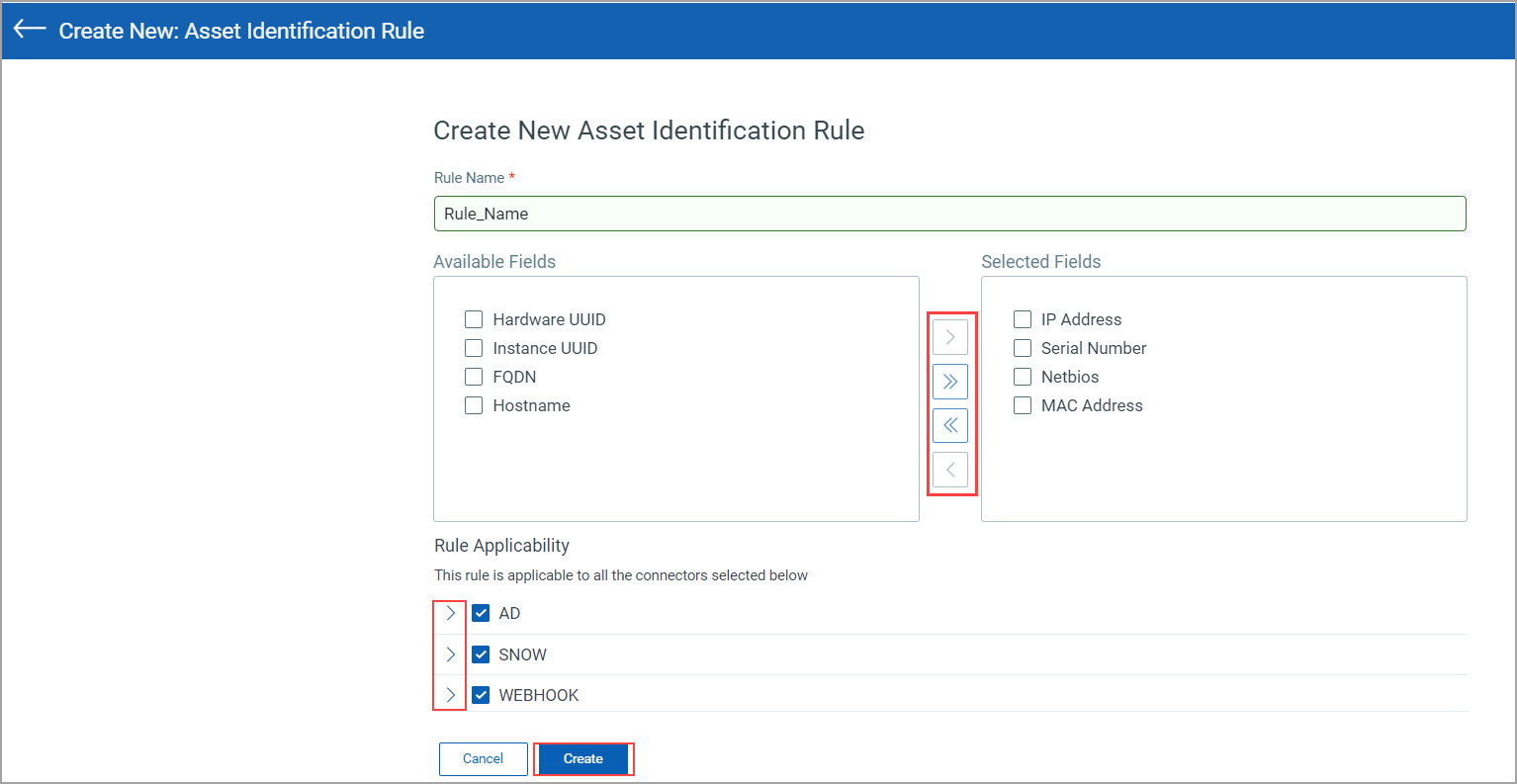
The rule is created, and you can view the rule details from the Configuration > Asset Identification Rules tab. You can view, edit, or delete it from the "Quick Actions" menu of the respective rule. Also, you can select multiple rules and delete them by selecting Delete from the Actions list.
Asset Identification Rules DetailsAsset Identification Rules Details
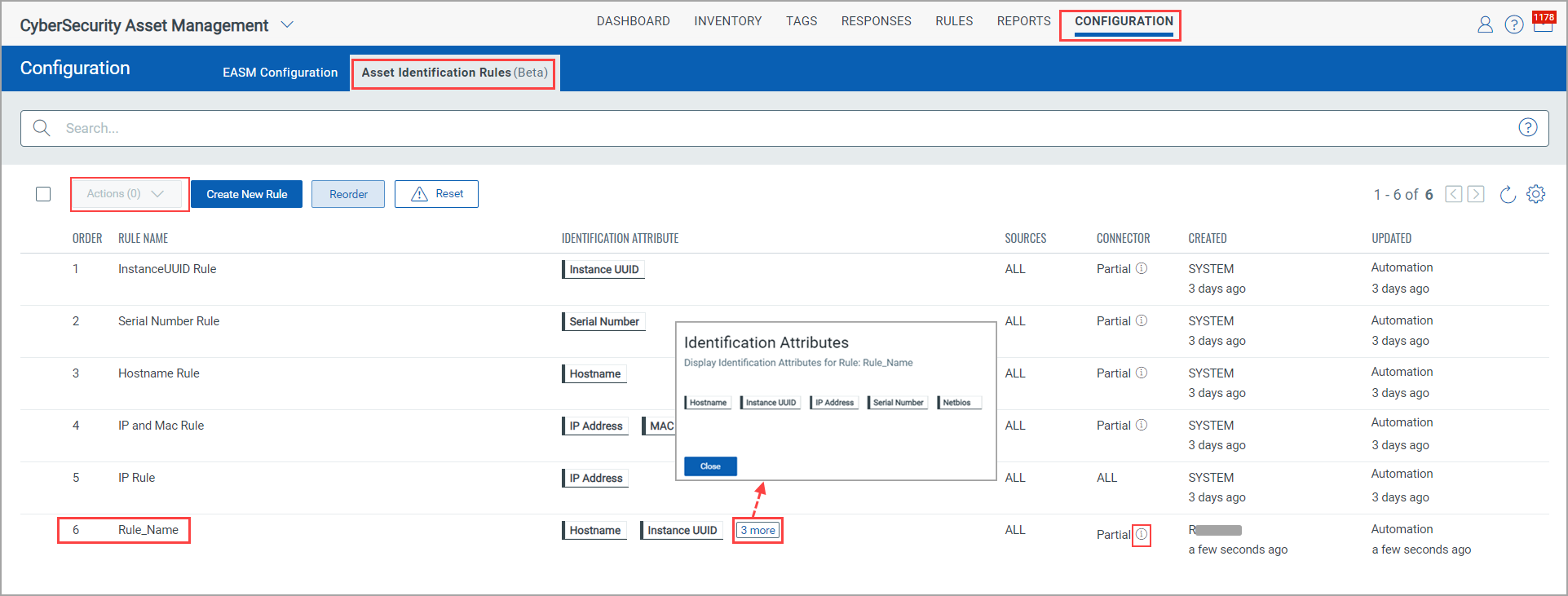
- From the Identification Attribute column, you can see the selected attributes for the rule. Two attributes are mentioned in the column. Click the link next to the attributes to see all the selected attributes.
- From the Sources column, you can see the value All if you selected all connectors and Partial if you selected a couple of connector sources.
- From the Connector column, you can see the value All if you selected all connectors from the connector sources and Partial if you selected a couple of connectors from the connector sources.
Suppose you don't select a couple of connector sources or connectors while creating the asset identification rule; you can see the list of those connectors and connector sources from the info icon next to the Partial status.
- From the Created and Updated columns, you can see the values System for the default rules. For the rules you create, you can see the user name.
Third-Party Assets into CSAM InventoryThird-Party Assets into CSAM Inventory
After the assets are imported based on the asset identification rules selected for the respective connector, they are merged and shown in the CSAM inventory. You can see the connector sources, first found, and last seen details under the Sources column.
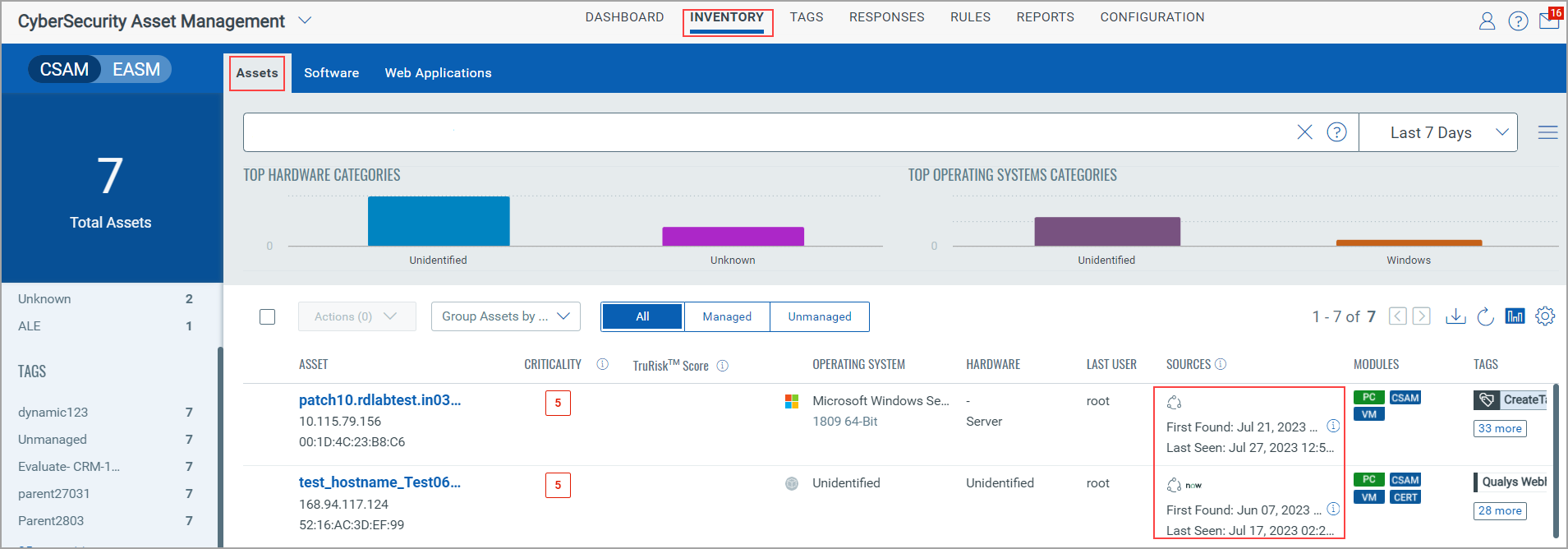
When you view the asset details, you can see the connector details, such as connector sources and connector names, on the Summary tab in the Sources section.
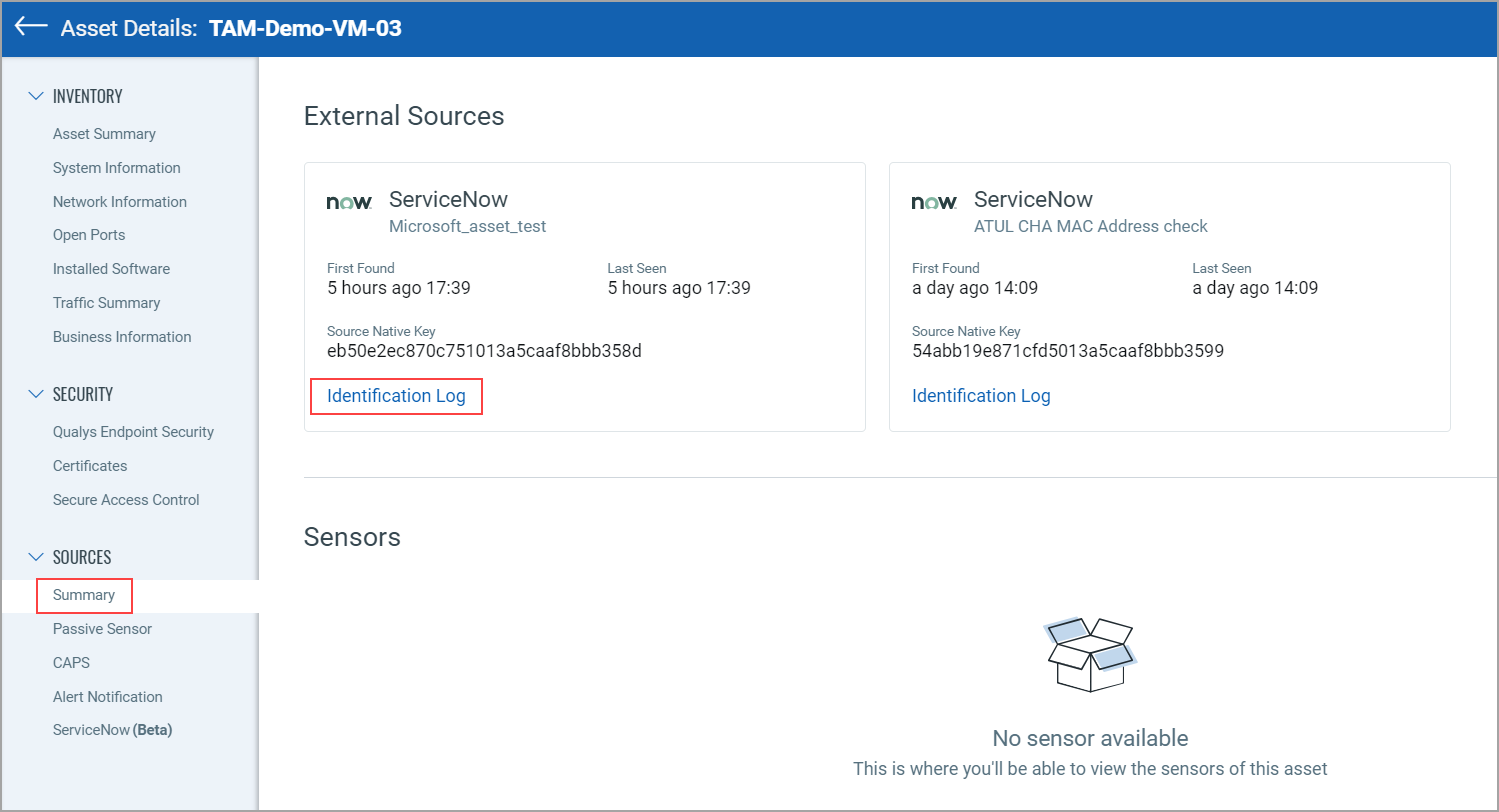
When you click the Identification Log link, you can see the asset identification rule names, identification attributes, and the result about whether the asset single match, no match, or multi-match is found. Asset Group Rule Version count shows the number of times the rule is edited.
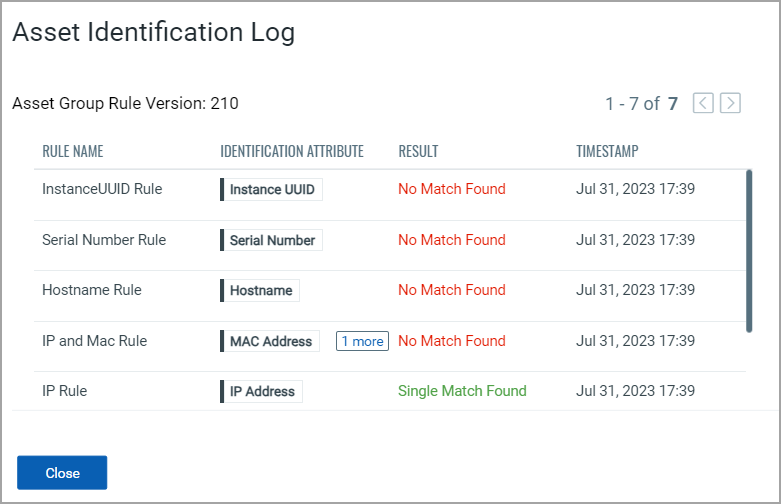
Source Native Key Rule:
The same asset is detected in the next sync from the same connector source and with the same connector source native key, then the default source native key rule is applied to it.
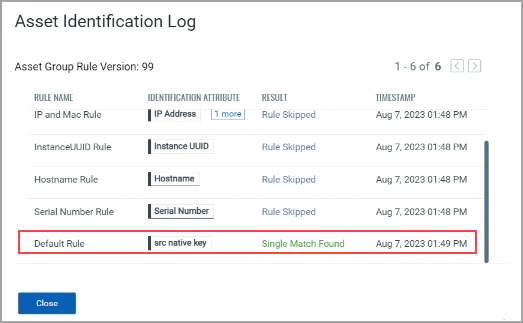
Qualys default asset ID rule:If the Qualys asset ID is identified in the sync, the Qualys default asset ID rule gets applied.
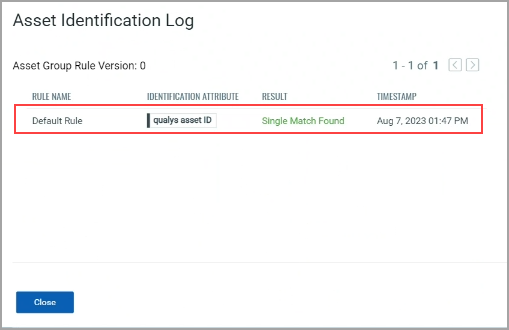
(a) On the Asset Details page, a new tab for the respective third-party connector source appears under the Sources section. This tab displays the connector associated with that source, along with its Custom Attributes and Identification Attributes. If the asset is discovered and imported into the CSAM inventory through multiple connectors, tabs for each respective connector are displayed.
(b) When multiple connectors are created, an individual tab is displayed for each connector.
(c) This section displays the Custom Attributes of the asset retrieved from the third-party connector. A maximum of 200 Custom Attributes are displayed for each asset.
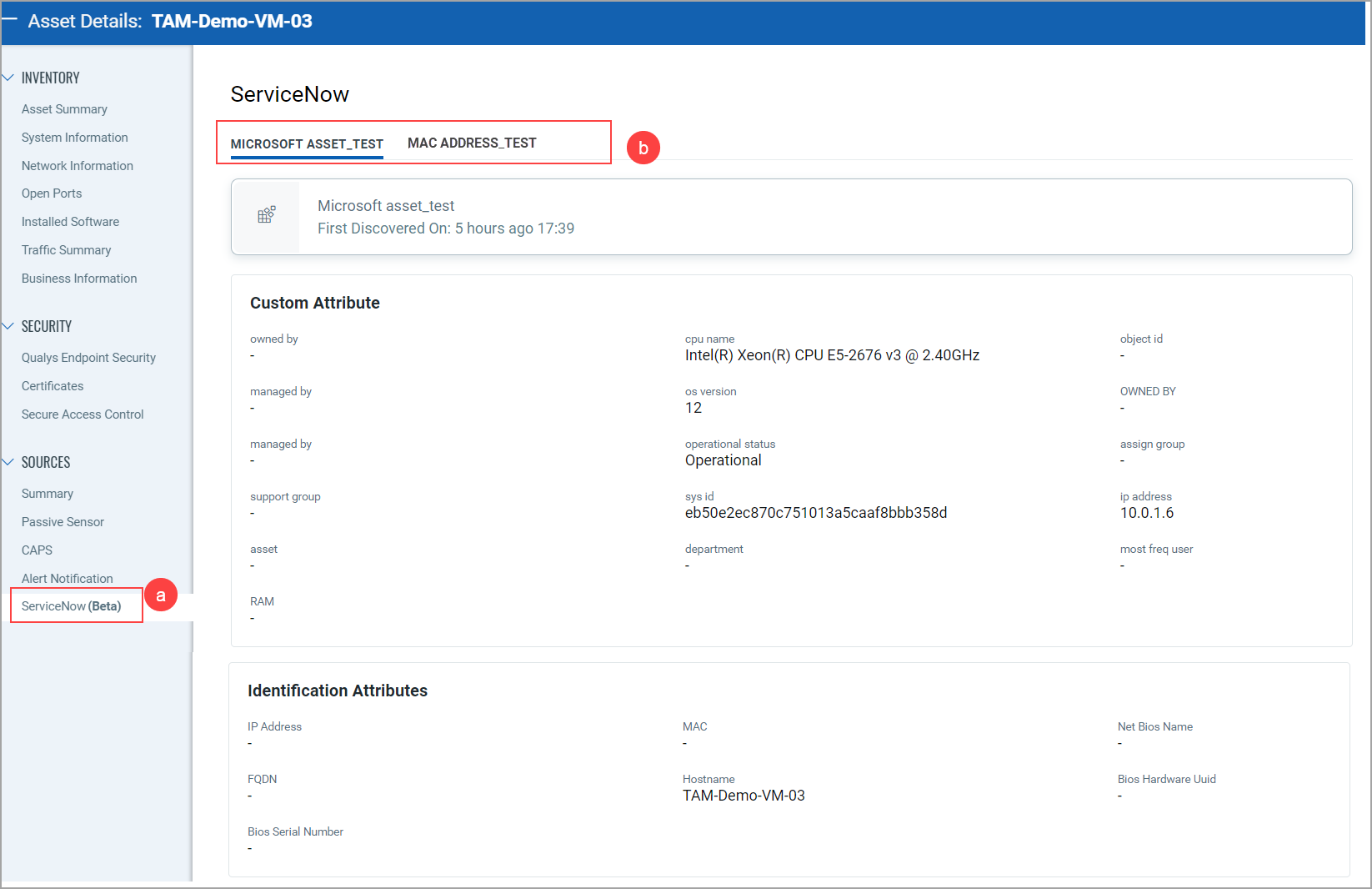
How to check if the Asset Identification Rule for Cloud Agent assets is being triggered
When an Asset Identification Rule is configured, it enables automatic Cloud Agent asset merging whenever a newly provisioned agent meets the criteria defined in that rule.
To verify whether the AIS merge was triggered, follow these steps:
-
Locate the asset you want to verify and open its Asset Details page.
-
In the Sources section, click Summary.
-
Select Identification Log.
- Review the log information:
- Provisioning Rule Name
- Identification Attribute(s)
- Timestamp
- Merge Result
In the Result field, verify whether the system detected a match for the identification attributes defined in the rule.
To view all rule condition settings for the Rule, open the rule in edit mode and use the dropdown to expand the full list of Primary and Secondary rule conditions.
What to do Next?
1. Connectors Creation1. Connectors Creation
The Webhook, Active Directory, and ServiceNow connector sources are created from the Connectors application. You need to create the required connectors for the respective connector sources.
For more information, see:
You can specify the Asset Identification Rule for the connector from the Connectors application.
The toggles next to the default or system-generated and user-created asset identification rules are turned ON by default. If you want to exclude specific Asset Identification Rules, you can do it by turning the toggles OFF.
To find detailed information about how the identification rules logic works, how the newly identified assets are merged into the existing assets, and the logic that explains how single-match and multi-match assets are found, refer to Identification Rule Selection.